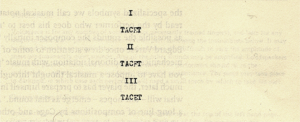“Music is the silence between the notes”
Attributed to Debussy and also Mozart
“…..the pauses between the notes – ah, that is where the art resides”
Artur Schnabel
“Music starts in the silence”
Stephen Hough, pianist
Beethoven: “Coriolan Overture”

The movements of Cage’s 4’33”, marked TACET, meaning “silent”
Just as in speech, silences in music can be used for emphasis, reiteration, and expression, or as a way of assisting the listener’s understanding of the music. They mark changes of pace or subject, allowing the listener to process the content and comprehend the structure of the music.
Schoenberg: Langsam from Six Little Piano Pieces Op. 19
Without pauses and silences, music would be monotonous and robotic. Some may argue that this is exactly the effect of the music by minimalist composers such as Philip Glass and Steve Reich, but listen carefully and there is an ebb and flow in this music – like the ebb and flow of human speech. A sensitive performer knows intuitively how to create space in this music.
Composers have always appreciated the value and drama of silences, from tiny agogic accents (a fractional pause before arrival at a particular chord or harmony to create greater impact or a stronger sense of delayed gratification) to whole bars of silence – a kind of musical “withholding of information” which has the power to retain the memory of what was heard before and create a sense of anticipation of what is to come. Silences create drama and relax tension, and provoke a whole range of emotions from anger to longing, nostalgia to excitement, terror to peace. A pause after an unresolved harmony or cadence can create a silence which is tense and fraught with emotion.
Philip Glass: Glassworks: I. Opening
Even when pauses and silences are not indicated in the score, skilled performers appreciate the power of “psychological silence”. Silences go beyond an ‘auditory signpost’ to guide the listener through the organisation of the music and strategically-placed pauses, which may not be indicated in the written score, can be used to heighten tension, create anticipation or deepen the emotional impact of the music. Thus silences become a way of manipulating the listener’s response to what they are hearing.
Silence is not “nothing”, as American avant-garde composer John Cage understood well. His infamous piece of conceptual art 4’33” challenges traditional notions of what constitutes “music” and reminds us that even when the pianist or other performers are silent, we still hear sounds – the sound of people breathing, turning a page in their programme, the creaks and sighs of the building.
Out of silence comes music, and that silence is the blank canvas on which the music is painted.
Debussy: Prélude à l’Après-midi d’un faune




